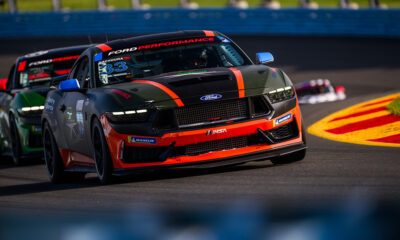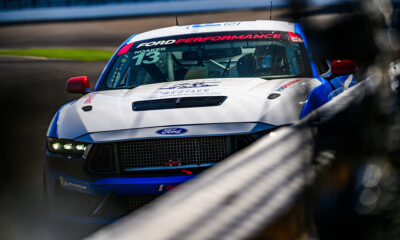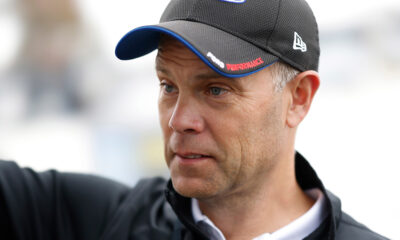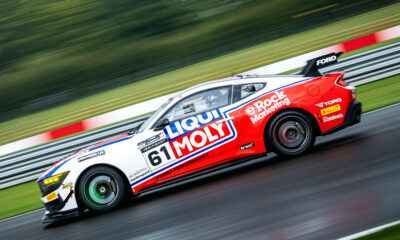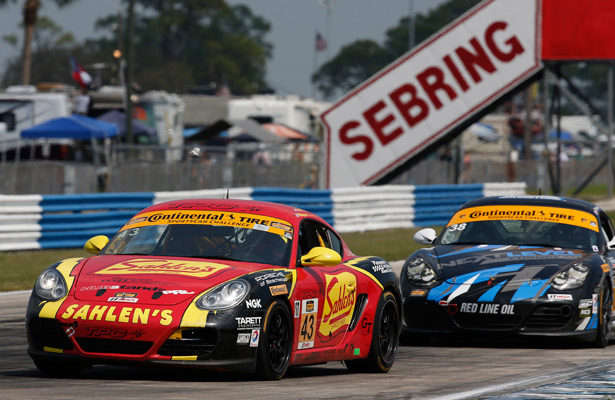
Photo: IMSA
You’ll often hear drivers say that the Twelve Hours of Sebring is the toughest endurance race in the world, even though it is only half the length of the iconic 24-hour races at Daytona, Le Mans, or Spa. This reputation is in large part due to the punishing nature of circuit at Sebring, comprised of equal measures technical complexity, unforgiving high-speeds, and brutally bumpy pavement.
Sebring is tough on the driver because there is very little margin for error and almost no time to rest, but it is even tougher on the car, which takes a relentless beating not seen at any other circuit in the world.
You could be forgiven for thinking that the task would be much simpler in the two-and-a-half hour Continental Tire SportsCar Challenge (CTSC) event, but you would be wrong. This past weekend 47 cars were on hand to compete in the Microsoft Visual Studio 150, and as usual with the CTSC series, what the race lacked in duration it more than made up for in intensity!
This was the second event for me driving Team Sahlen’s Porsche Caymans in the ST class, and after a disappointing outing at Daytona, we were eager to get our season back on track. We got started with the mid-week promoter test-day and worked our way through a laundry list of setup items that the team wanted to evaluate to get the car optimized for the weekend.
The good news was that we were very quick right away, which was a great reward for the team after a few months left to stew on the Daytona disappointment. Team Sahlen has clearly done their homework on this car, and I was really impressed with how well behaved the car was from the outset.
We spent the remaining practice sessions trying various tweaks to squeeze a bit more speed out of both cars, and though it can be a bit challenging for a driver to jump back and forth between two cars and evaluate two different setup paths during a single session, the end result is that we have a lot more data to work with and we can improve our setups much faster than most teams.
By the time we got to qualifying, I felt really good about our prospects, and joked with the team’s engineers that they should savor the moment because it isn’t often that I’ll get out of a racecar and say “it’s perfect, don’t touch anything!”
Ultimately, qualifying was a bit disappointing for us, but only because a few other cars had managed to find more speed than we expected, and we were left fifth on the grid. I wasn’t really surprised with our speed—my two fast laps in qualifying were within .01 of each other, and also within .01 of the mock-qualifying lap I had done earlier in practice. At least we were pretty consistent…
Fifth wasn’t exactly what I had hoped for, but things looked encouraging for the race. We knew there was a slim chance that we could do the race with just one fuel-stop if we were careful, so we planned accordingly and hoped that our competitors would need to make an additional pit stop.
The plan for me was similar to Daytona, in that I would start in one of the team’s cars, and finish in the other. At Daytona I jumped out of one car and didn’t even have time to get completely over the pit-wall before it was time to get into the other car, and given the tight fuel window at for this race, it looked likely that I would be doing the same thing again.
While double-duty at Daytona was a bit of a challenge, this race was on an entirely different level of difficulty. Sitting on the pre-grid I saw the car registering an ambient temperature over 95-degreees, with searing sunshine that had made the track hotter and greasier than anything we had encountered in practice.
At the start, I was very aggressive to try and move to the front of the field (maybe a bit too aggressive into the hairpin on Lap 1—thanks to Adam Isman for giving me some room to gather it up without taking us both out!). The car felt pretty good, but the track conditions were deteriorating quickly, and I could see that tire management was going to be an issue for us with just one scheduled pit stop.
We had a few early full-course cautions, and just like Daytona, I took full advantage of the restarts to pick off a few cars at a time, eventually getting into the lead before the end of the first hour.
We pitted from the lead under a well-timed caution, and my co-driver Wayne Nonnamaker took over the No. 43 for the finish. Meanwhile, I jumped out of the car and only took about five steps down pit lane where my other teammate Will Nonnamaker was already waiting for me with the No. 42 car, which had been running strongly in sixth place.
A good stop for the No. 43 kept that car near the front of the field, but we had a problem with an air gun on No. 42, which meant I restarted the race in last place with a lot of work to do. A long, hot, difficult race for me in two different cars had just gotten a whole lot more challenging…
In the end, our one-stop fuel strategy just barely got both cars to the finish on fumes, but unfortunately we weren’t able to maintain the pace of the leaders while saving fuel and trying to preserve our tires. Wayne brought the No. 43 home in a respectable fifth place, while I was able to salvage a sixth place in the No. 42 after coming back through the field.
While nobody was ecstatic with the result, it was a solid points day for both cars, and that’s important given the team’s championship aspirations. Now we’ll regroup, get back to work on the cars, and try to find just a bit more speed so that we can challenge for the win next month at Laguna Seca.



















